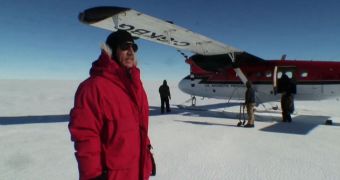Expert Robert Bindschadler, who holds an appointment as an emeritus glaciologist at the American space agency's Goddard Space Flight Center (GSFC), in Greenbelt, Maryland, will lead the international collaboration of researchers that will start studying the Pine Island Glacier next month.
The expedition is the most complex and well-prepared ever deployed to this remote region. The reason why this particular glacier is so important to scientists is that it is responsible for releasing more than 19 cubic miles (79.2 cubic kilometers) of ice into the Southern Ocean each year.
Satellite measurements revealed that this ice sheet has the potential to contribute significantly to global sea level increases. Experts therefore want to know how fast the glacier is moving, and also how oceanic waters underneath heat it up over the course of a year.
For this purpose, NASA and the US National Science Foundation (NSF) will deploy a team of 13 researchers on the Pine Island Glacier, via helicopters, this December. Bindschadler will lead and coordinate the entire group, which is scheduled to remain in the field for about 6 weeks.
“The Pine Island Glacier ice shelf continues to be the place where the action is taking place in Antarctica,” the GSFC expert says. But this ice sheet is not the only one shedding a lot of ice into the ocean. Similar situations can also be found in Alaska and Greenland, in the Northern Hemisphere.
“It only can be understood by making direct measurements, which is hard to do. We're doing this hard science because it has to be done. The question of how and why it is melting is even more urgent than it was when we first proposed the project over five years ago,” he goes on to say.
One of the most complex tasks the team will have to complete is assess the manner in which winds, water and ice interact on, above and under the Pine Island Glacier. All these factors influence its movements and behaviors, but scientists do not yet know to what extent each of them triggers changes.
“The team will use a hot water drill to make a hole through the ice shelf. After the drill hits the ocean, the scientists will send a camera down into the cavity to observe the underbelly of the ice shelf and analyze the seabed lying approximately 1,640 feet (500 meters) below the ice,” a NASA statement says.
“The primary instrument, called a profiler, will move up and down a cable attached to the seabed, measuring temperature, salinity and currents from approximately 10 feet (3 meters) below the ice to just above the seabed,” the agency informs.
About 35 holes will be dug in total, at just as many locations. Helicopters will deploy the research team wherever needed, and will pick them up shortly after their work is done.

 14 DAY TRIAL //
14 DAY TRIAL //